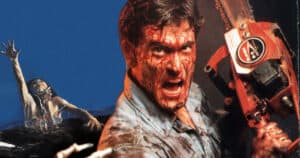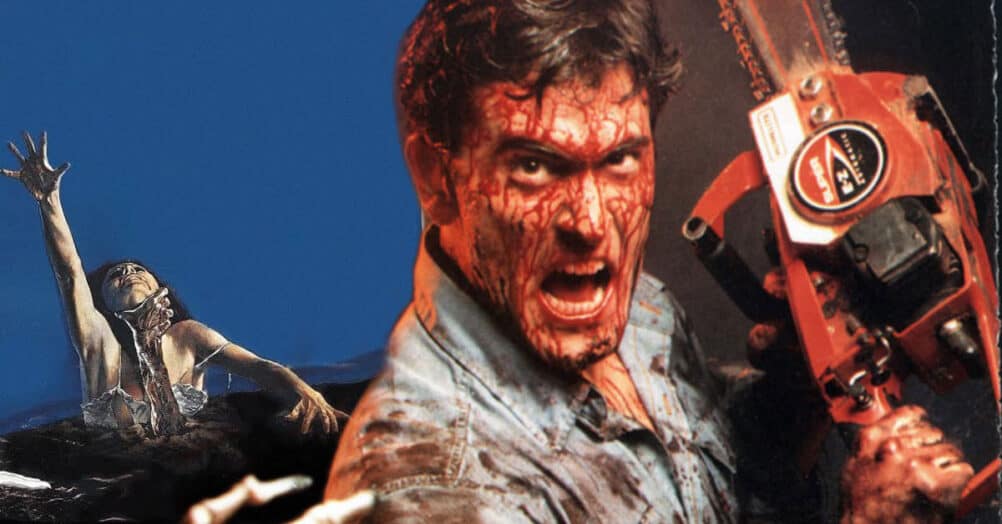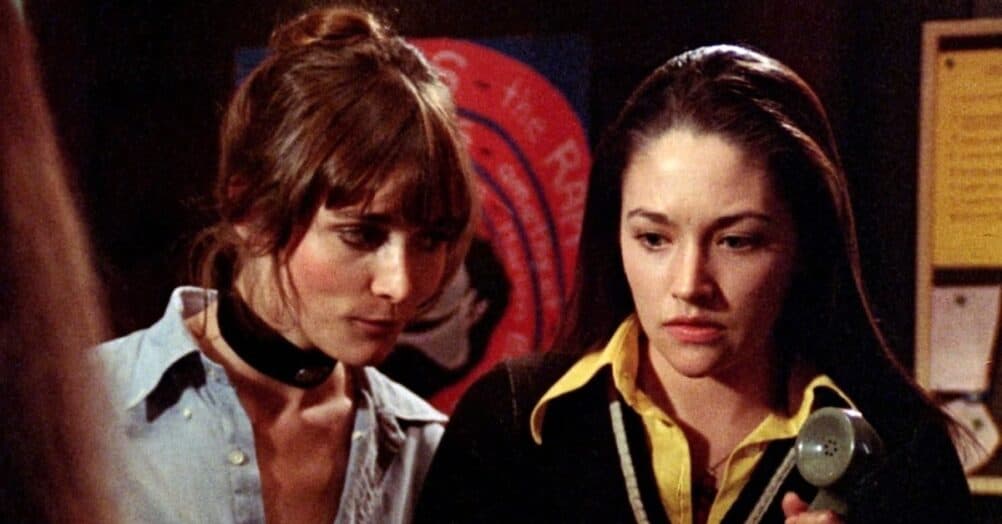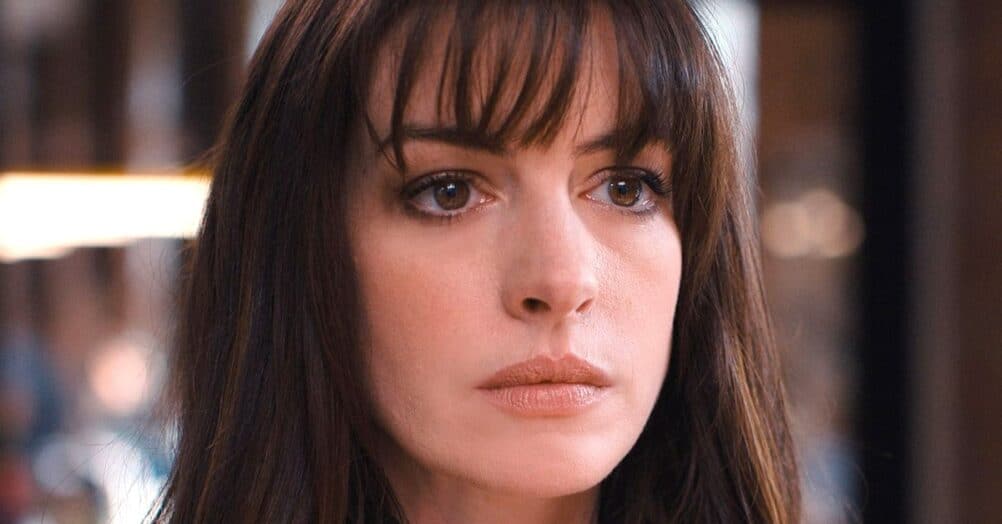Last Updated on July 23, 2021

Guest Interview, conducted by Marco Freitas.
Born in England in 1946 to a father serving in the Royal Air Force, Brian Trenchard-Smith movies have generate cult followings all over the world. About three years ago, the release of the famous documentary on Bmovie mavericks from Down Under NOT QUITE HOLLYWOOD: THE WILD, UNTOLD STORY OF OZPLOITATION, with interviews with Trenchard-Smith among other filmmakers, opened the eyes of a whole new generation of fans to his theatrical, tv, and cable-made films.
Helmer of diverse filmes like TIDES OF WAR, NIGHT OF THE DEMONS 2 and AIR FORCE 2 (both available in regular versions as well as versions for the gay market), LEPRECHAUN 3 and 4, the christian-themed MEGGIDO: THE OMEGA CODE 2, the war drama SAHARA and many more, Trenchard-Smith, one of Quentin Tarantino´s favourite directors, was kind enough to talk about his career and his talent for turning meager-budgeted flicks into large-scaling features.

What´s your earliest memory of watching films?
On a sheet hung outside at the air force base my father commanded on the African north coast 1948 – 1951. I have vague memories of color, movement, horses. Was it a western? Maybe.
It says on your bio that you´ve attended UK’s Wellington College, where you´ve neglected studies in favor of acting and making short films. What was your major at the time?
Wellington College was one of the top 5 ” public schools ” (private) in England. I underperformed at Math and Science, did better with History, Latin, Greek.
What drove you to start making short subject films?Can you tell us about the first short subjects you´ve made there?
I wanted to create scenes I enjoyed in the cinema with whatever resources were available, like a friend who had a camera. I paid for some of the rolls of 8mm. When I was 15, I made a 2 minute short, THE DUEL. I was a fencer and staged a duel in which I was the loser, dying with tomato ketchup on my white shirt. At 16, I made THE CHASE at 10 minutes. The school was close to the Broadmoor Psychiatric Institute for the criminally insane. We went to the high walls that surrounded the building and staged the escape of a homicidal maniac, armed with a WW1 bayonet. He chased me at great length around the countryside, before stabbing me, whereupon I rolled down a steep slope into a quarry. My first stunt I guess. In my final year the school commissioned me to make a year long record of the schools activities to show to parents of prospective pupils. They gave me a camera and as much film as I needed This time I shot it all myself. It had a 20 man battle scene which I staged with the aid of the Cadet Corps. So you can see where my earliest
instincts were leaning…
I could have gone on to University, but I’d had enough of academia, wanted to get started in my chosen career – film making. Of course that was not easy, because the film industry union operated a closed shop. I would have to spend 4 years working in a laboratory ( inhaling formic acid) before being allowed to be a junior in the cutting room. So I went to the land of my father, Australia, which had no film industry but 4 TV networks, and no union restrictions. ( I am in favor of unions, particularly now, given the concentration of wealth in the hands of a few) I wrote a glowing reference for myself on the letterhead of a London company I had briefly worked for as a clapper loader, and set off. I had a job 3 weeks after my arrival in Sydney. I had edited 8 mm films at school, so I said I could edit 16 mm news. I quickly learned the film grammar, and shorthand necessary to depict an event in between 20 and 45 seconds.
After moving to Australia, you´ve became a news film editor. Do you think that experience helped your understanding of the pacing in films later on?
Newsfilm editing provided a good foundation, but it was promo/trailer writing and editing that particularly developed my personal approach to pacing, which is: get on with it, move fast, keep the audience’s attention.
Though you were an experienced editor of trailers and documentarian, you were still a newbie to narrative fictional films when you got to helm THE MAN FROM HONG KONG. Tell us about the process you went through to convince mogul Raymond Chow and producers Andre Morgan and John Fraser you´d be able to direct the ambitious film.
I made a dramatized documentary for Australian television called ‘The Stuntmen’. The film is available in the US on the second disc of the Code Red DVD release of ‘Stunt Rock’. ‘The Stuntmen’ won me an award at the Sydney Film Festival. I staged a lot of different action scenes in it, it showed I had an eye for that kind of material. I used it as a calling card to get the attention of Raymond Chow at Golden Harvest in Hong Kong. I told him I had an Australian distributor/exhibitor willing to put up half the budget for MFHK. (Just a pitch at that time, but who dares wins…) He said he would match it. Then I went back to the Australian distributor/exhibitor and said I had Golden Harvest’s commitment for half. Would they like to match it? Luckily the project suited both parties’ agenda at the time.

(Jimmie) Wang Yu was a major star who also had directed eight movies prior to doing The Man From Hong Kong. Please tell us your memories of doing a martial arts saga produced by both Australians and Chinese
This was my first big movie. So, part of the co-production deal was that Wang Yu would get co-directing credit in the Asian markets where his fan base expected it., but not in the international version, my version, which was released everywhere else.. It was just something I had to accept. But I directed the film, I wrote it. My personality infuses its sensibilities. I did naturally listen to Wang Yu and Sammo Hung very closely about the choreography of the fight sequences, so direction requires collaboration. Also if you know Wang Yu’s work as a director – Beach Of The War Gods is my personal favorite – he’s got real talent.
So I has quite happy to have him spend a day directing a section of the car to car duel ( bashing into each other just before the car goes through the house) while I used the main unit elsewhere in scenes that did not involve him. The fight scene between Wang Yu and Grant Page in the kitchen, like all of them, we worked it out together. In the script, I had written that their brawl uses “every implement in the kitchen.” So I laid out the broad strokes.. I said, “oh there’s a frying pan – use that”, “there’s a giant hook use that”, and then the guys would choreograph it out. The DP Russell Boyd and I would decide how to shoot it We had only two nights to do that kitchen sequence. Good the car to car duel ( bashing into each other just before the car goes through the house) while I used the main unit elsewhere in scenes that did not involve him.
Sammo Hung is credited as Martial Arts Choreographer in the movie. Tell us about your experience working with him.
Sammo was 22, spoke no English, was very funny, we got on famously. He was very inventive and surprisingly athletic for his build. He liked my request
for “dirty fighting”. His huge career since is indicative of his early talent.
I’m very fond of DiscoMusic. Tell us about the choosing of JIGSAW as the performer of SKY HIGH in THE MAN FROM HONG KONG soundtrack and working with 70s music producer Bebu Silvetti in DAY OF THE ASSASSIN.
I had nothing to do with post production on Day of the Assassins, they would not pay me so I moved on. I have written about it in a blog: I had a lot to do with the music of MFHK, and worked closely with conductor Noel Quinlan, the HK based composer. He had written a title song that was quite good. But when British distributors saw the film, they thought a name band like Jigsaw would add significant promotional value. So Jigsaw wrote a song as a single, then did an extended version to match the length of the title sequence. Sky High became a No.1 hit across the world.
You play a thug in the movie and the star supposedly hit you for real in a fight scene on it. Playing a part yourself was that a decision to cut costs?
Part vanity, part cost cutting. That character was in both the gymnasium scenes to be shot in Hong Kong, and the corridor and elevator scenes to be sot in Sydney. So if I played the part, there was no extra cost.
The second Unit work in MAN FROM HONG KONG is quite impressive (the car chases are spectacular). Can you tell us a bit about working on them with the second Unit crew?
All the fights and alot of the car chase were main unit work. I enhanced the foot chase and car action with additional incidents via 2nd unit, when I had a loose assembly. Then at the very end, I did the building explosion exteriors with a 3 camera 2nd Unit.
I´m sure there would be no DEATHCHEATERS nor STUNT ROCK if you´d never met the daredevil stuntman Grant Page. How did you guys meet?
I needed some rope slides in The Stuntmen, and was introduced to Grant Page, as a former commando, who could rappel off cliffs. We immediately hit it off. I put him under a 5 year contract of management, with a view to
making him as an action star who could be seen to be doing his own stunts, like Errol Flynn did. ( Also Australian) So I created vehicles in which he played leading roles and showed his amazing stunt expertise. Kung Fu Killers, Deathcheaters, Stunt Rock etc, as well as getting him the best stunt rates I could. We were both very good for each other’s careers.

How was working with method actor Steve Railsback in TURKEY SHOOT?
Steve was great, yes, very method but very committed, no problem for me. It was the producers he had the beef with, due to the budget cuts.
How was your experience working with famed-and n my opinion an unsung hero un Australian Cinema-the late musician and composer Brian May (NOT the Queen bass player)
(the score for TURKEY SHOOT is quite effective)?
Yes, Brian made a huge contribution to all the Australian films he composed for. It was a pity I only got to work with him once. And on a film were budget cuts made it impossible for him to use the level of orchestra he
normally did.
Considering the left-of-center humour that permeates many of your films, I´d like to know if you see TURKEY SHOOT as an allegory of the despotic political climate in the 80s in some regions of the world. or if it already was in the writing (Neil Hicks was a Screenwriting teacher of mine at UCLA).
I developed the script closely with Neill Hicks and Jon George, so the political satire was there from the beginning. The original script was sort of like ‘I Was A Fugitive From A Chain Gang’ meets ‘The Most Dangerous Game, with 70 pages of ‘Chain Gang’ and ‘Most Dangerous Game’ lasted about 35 pages. I didn’t think that was good balance. Also it was set in the depression era Deep South. We had tax based financing in place on condition that it was supposed to be set in Australia. So I suggested we set it in the future, and make it more universal. We wanted to make a tongue in cheek but gutsy action movie with subtext about corporate fascism at the beginning of the Reagan era. (He had Australia frightened…Ronald Ray Gun cartoons
were often spray painted on Sydney walls in 1981) So we hired Neill & Jon to redo it. Then of course, there were days when I was writing pages myself during the shooting.
How was working with famous cult icon actor David Hemmings. as one of your Exec Producers in the film?
We had a difficult relationship as he too was also a director. He did not think much of me. He knew that a Completion Gurantor had me waiting in the wings to take over an earlier film Hemmings was directing if he continued to remain behind schedule. He was having an on again off again affair with a member of the cast. When he made fun of me in front of my wife and new born son once in the production office, I poured beer on his head. He was a little more careful with me after that.
Was Nicole Kidman easy to work with in BMX BANDITS?
Nicole was a dream to work with. The producers weren’t wild about my choice at first. She was written as the tag along girl yet she was taller than the two boys. I start putting her in the foreground as much as possible. The camera loves her, and her natural charm and comedy timing quickly established her at the film’s premiere as an ingenue every Australian director wanted to cast. That led to Dead Calm which led to Tom Cruise. But even if she had never met him, she would have become a star in her own right.
How was working with Everett de Roche in THE QUEST/FROG DREAMING? And with Henry Thomas, only a few years fresh off E.T. ?
Everett is Australia’s greatest genre writer. Thank God there weren’t studio development executives around in the early days of the Australian cinema renaissance to meddle with his imagination. Henry Thomas at 14 , like Nicole Kidman at 15 , had natural acting ability. You could see why Spielberg cast him. I cast him again when he was 28 in the movie Happy Face Murders, and he was still the skilful actor and unassuming, decent human being he
was 14 years before.

What attracted you to the DEAD-END DRIVE IN, Mr. Trenchard-Smith? Had you read Peter Carey´s short story CRABS previously ?
No I had not read it. I got the job because the previous director was unhappy with the script, and lost faith in the project. I came in, took a week, and welded the best elements from the first three drafts together, boosting the social comment.
Lawrence Eastwood´s and Nick Mccallum´s art direction in the movie is quite impressive and really helps the storytelling with their visuals. How was it working with them?
Lawrence and Nick were fantastic, great ideas, great execution for a 2.5 million dollar movie. Anytime they asked if a visual concept was going too far, I said go further. They deserved the award for design, but it went
elsewhere.
How were the filming conditions in the Philippines on SIEGE OF FIREBASE GLORIA?
When we shot the film-In 1988-, the Philippines was still in the grip of two insurgencies, an Islamic one in the South, and the communist New People’s Army (NPA) on the main island of Luzon where we were. So an hour‘s drive out of Manila we were already crossing the perceived border beyond which lay NPA contested territory, and we had an hour’s driving to go. “Don’t worry about the NPA, sir, they are the Good People.” I mistook this for character evaluation. In fact it was an item in all Philippino movie budgets at the time. Ostensibly, it referred to security staff for locations outside Manila. Indeed, who better to protect you from the NPA than the NPA themselves? I was told that they were better than the Philippino military. They did not get drunk, or bring their cousins demanding they get paid as well.
How was your experience working with US actors Lee Ermey and Wings Hauser? For my money, two of the more intense low budget films Their acting in SIEGE OF FIREBASE GLORIA is among their very best in their extensive filmographies.
I agree. They both deliver masterful performances. Wings depiction of a man driven crazy by war is heartfelt and scary. I had met nor spoken to Lee prior to arriving. So once he arrived , I fell in love with Lee’s sense of humor and his take on things. Probably like how Stanley Kubrick probably fell in love with him on ‘Full Metal Jacket.’ and promoted his Marine advisor to the role of Sgt. Major Hartman. I showed him the location we picked for the firebase and he approved. Lee did change alot of his own dialogue to what a marine would say. The original script featured Army soldiers, and Lee suggested that his patrol be Marines that took over an Army base. So I went along with his ideas. He came up with the whole thing about their being no atheists in a foxhole. Lee and I re-wrote the severed heads scene in the script as well. The original scene was somewhat different in the script, not memorable really. I thought just pointing to the severed heads was not enough. What if he was carrying them? So while they were setting up the lights, Lee and I were brainstorming it out, and as we were doing that I was writing everything down. Now, it’s the scene that everyone remembers from the film. Lee and I share an additional dialogue credit at the end.
Is there any secret you could reveal to us regarding what do you do to make your movies look like they cost soooo much more than their usually cheap budgets?
First, be a good leader, kind father, energetic brigade commander to your cast and crew; no one gives their best in an atmosphere of blame and fear, as happens on big star driven movies; humor is much more effective in team
management; try to make your own enthusiasm for the project contagious to everybody. Then pick locations that have natural production value. All the harbor exteriors in MFHK and BMX Bandits hardly cost a penny. Plan well. Shot list. Make every hour of shooting count.

















Follow the JOBLO MOVIE NETWORK
Follow us on YOUTUBE
Follow ARROW IN THE HEAD
Follow AITH on YOUTUBE